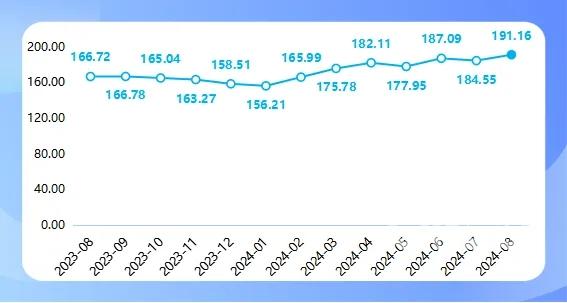Market supply is limited, driving the squid price index to rise sharply
1. Overall Performance of the Index Operation
According to data observations from Zhejiang Zhoushan International Agricultural Products Trade Center Co., Ltd.: In terms of the monthly price index operation, the monthly price index for China's distant ocean squid rose significantly in August 2024, closing at 191.16 points, an increase of 3.58% compared to the previous month. In terms of the weekly price index operation, the price index steadily increased each week in August. Among them, the second week saw the largest increase, reaching 2.79%; by the end of August, the index closed at 187.11 points, up 6.23% compared to the end of July.
2. Analysis of the Price Index Trend of Squid in August 2024
The China Ocean Squid Price Index rebounded from a high level, closing at 191.16 points, with a month-on-month increase of 3.58%. Recently, there are still no signs of improvement in global squid catch volumes, and market supply remains constrained. Although high prices have had a certain suppressive effect on market demand, the impact is limited, and squid prices continue to operate at high levels.

In August 2024, except for a slight decline in the squid price index in the Northwest Pacific Ocean, the squid price indices in other sea areas all experienced varying degrees of increase.
The squid price index in the Southeast Pacific region has seen the largest increase, closing at 196.84 points, up 4.20% month-on-month. Peruvian squid produced in the Southeast Pacific has consistently held a significant share in the global squid market, and its production levels greatly influence squid price trends. However, since the beginning of this year, the production of Peruvian squid has sharply declined. According to official data from the Peruvian Ministry of Production, the squid catch in the first half of this year was only 140,000 tons, a decrease of 70% compared to the same period in 2023. In August, the squid catch in Peru remained weak, and as inventory continues to be consumed, there is strong upward pressure on prices.
The squid price index in the Southwest Atlantic Ocean region increased next, closing at 182.42 points, a month-on-month rise of 2.70%.
The Peruvian squid produced in the Southeast Pacific has consistently held a significant share in the global squid market, and its production levels greatly influence squid price trends. However, since the beginning of this year, the production of gigas squid has sharply declined. According to official data from the Peruvian Ministry of Production, the squid catch in the first half of this year was only 140,000 tons, a decrease of 70% compared to the same period in 2023. In August, the catch of Peruvian squid remained weak, and as inventory continues to be consumed, there is strong upward pressure on prices.
In the southwestern Atlantic Ocean, the squid price index rose by 2.70%, closing at 182.42 points. In August, the supply of Argentine squid from the southwestern Atlantic was relatively sufficient, but due to poor catch conditions in other regions, the overall squid supply decreased, leading to an increase in demand for Argentine squid in the market, which drove the price index upward.
Driven by the price increase of certain specifications of squid products, the squid price index in the Indian Ocean region has rebounded, closing at 181.64 points, with a month-on-month increase of 2.13%.
Unlike the trends of the other three major oceanic regions, the squid price index in the Northwest Pacific region has slightly decreased, closing at 161.54 points, with a month-on-month decline of 0.40%. Currently, China's annual catch of deep-sea squid is around 600,000 tons, with over 85% being Peruvian giant squid, 12% Argentine squid, and a relatively low proportion of North Pacific squid and Indian Ocean squid. The low production of North Pacific squid is due to the depletion of squid resources in the high seas of the North Pacific. As a result, the squid prices in the Northwest Pacific region have remained relatively stable. Although this period's index has declined, the drop is small, and the overall fluctuation is not significant.

4. Market Situation
Looking ahead in the short term, there are no signs of improvement in squid catch volumes in the Southeast Pacific region. Meanwhile, China's self-imposed fishing moratorium in the southwestern Atlantic will last until the end of September. During this period, the supply of Argentine squid in the market will mainly rely on imports, and short-term shipping prices are likely to remain high. Considering various factors, the tight supply situation in China's squid market may continue in September, which will drive the squid price index to maintain a high level of fluctuation.





